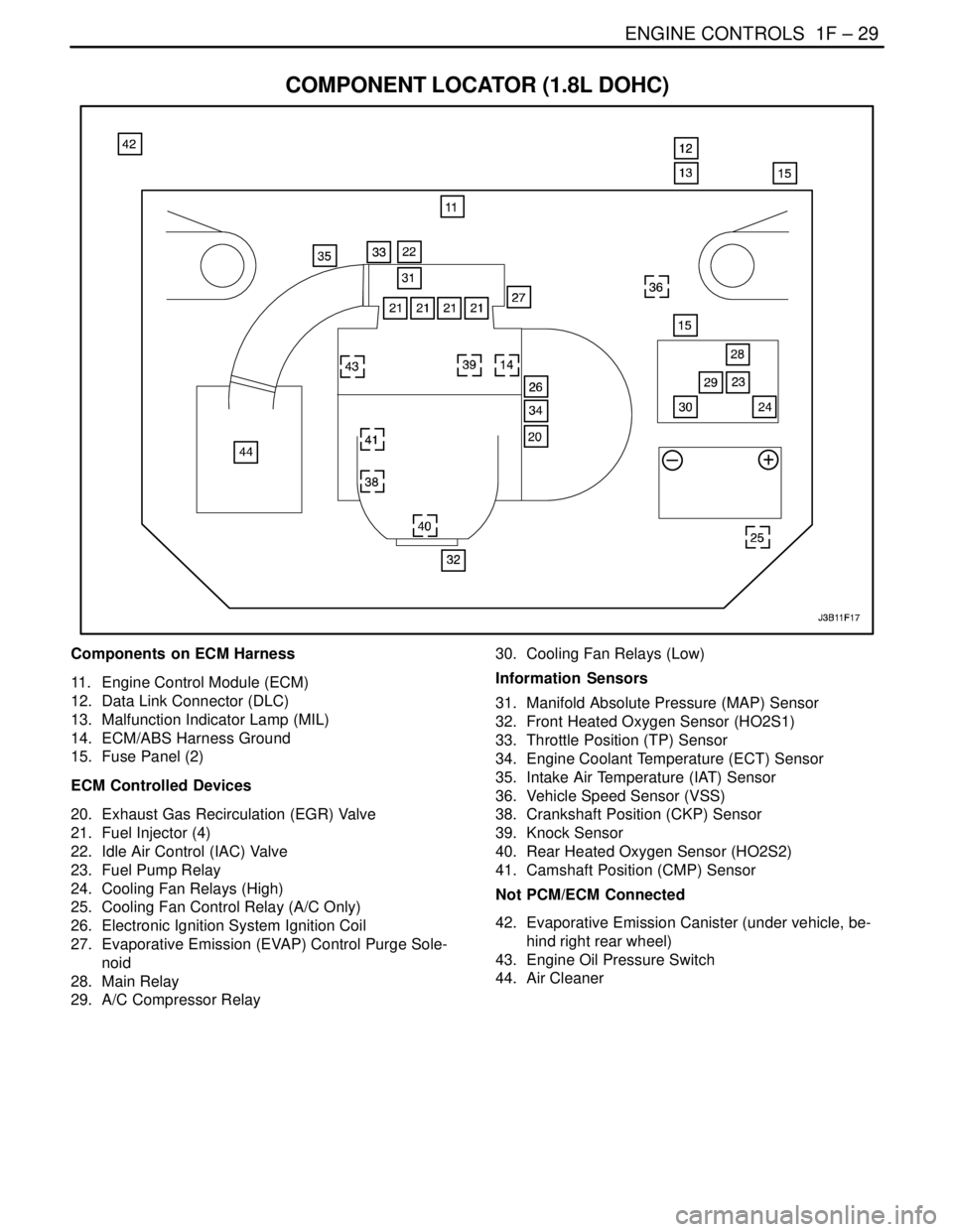2004 DAEWOO LACETTI Map sensor
[x] Cancel search: Map sensorPage 275 of 2643

ENGINE CONTROLS 1F – 29
DAEWOO V–121 BL4
COMPONENT LOCATOR (1.8L DOHC)
Components on ECM Harness
11. Engine Control Module (ECM)
12. Data Link Connector (DLC)
13. Malfunction Indicator Lamp (MIL)
14. ECM/ABS Harness Ground
15. Fuse Panel (2)
ECM Controlled Devices
20. Exhaust Gas Recirculation (EGR) Valve
21. Fuel Injector (4)
22. Idle Air Control (IAC) Valve
23. Fuel Pump Relay
24. Cooling Fan Relays (High)
25. Cooling Fan Control Relay (A/C Only)
26. Electronic Ignition System Ignition Coil
27. Evaporative Emission (EVAP) Control Purge Sole-
noid
28. Main Relay
29. A/C Compressor Relay30. Cooling Fan Relays (Low)
Information Sensors
31. Manifold Absolute Pressure (MAP) Sensor
32. Front Heated Oxygen Sensor (HO2S1)
33. Throttle Position (TP) Sensor
34. Engine Coolant Temperature (ECT) Sensor
35. Intake Air Temperature (IAT) Sensor
36. Vehicle Speed Sensor (VSS)
38. Crankshaft Position (CKP) Sensor
39. Knock Sensor
40. Rear Heated Oxygen Sensor (HO2S2)
41. Camshaft Position (CMP) Sensor
Not PCM/ECM Connected
42. Evaporative Emission Canister (under vehicle, be-
hind right rear wheel)
43. Engine Oil Pressure Switch
44. Air Cleaner
Page 282 of 2643

1F – 36IENGINE CONTROLS
DAEWOO V–121 BL4
MULTIPLE ECM INFORMATION SENSOR DTCS SET
Circuit Description
The Engine Control Module (ECM) monitors various sen-
sors to determine engine operating conditions. The ECM
controls fuel delivery, spark advance, transaxle operation,
and emission control device operation based on the sen-
sor inputs.
The ECM provides a sensor ground to all of the sensors.
The ECM applies 5 volts through a pull–up resistor and
monitors the voltage present between the sensor and the
resistor to determine the status of the Engine Coolant
Temperature (ECT) sensor, the Intake Air Temperature
(IAT) sensor. The ECM provides the Exhaust Gas Recir-
culation (EGR) Pintle Position Sensor, the Throttle Posi-
tion (TP) sensor, the Manifold Absolute Pressure (MAP)
sensor, and the Fuel Tank Pressure Sensor with a 5 volt
reference and a sensor ground signal. The ECM monitors
the separate feedback signals from these sensors to de-
termine their operating status.
Diagnostic Aids
Be sure to inspect the ECM and the engine grounds for be-
ing secure and clean.
A short to voltage in one of the sensor circuits can cause
one or more of the following DTCs to be set: P0108,
P0113, P0118, P0123, P1106, P1111, P1115, P1121,
P0463, P0533.
If a sensor input circuit has been shorted to voltage, en-
sure that the sensor is not damaged. A damaged sensor
will continue to indicate a high or low voltage after the af-
fected circuit has been repaired. If the sensor has been
damaged, replace it.
An open in the sensor ground circuit between the ECM and
the splice will cause one or more of the following DTCs to
be set: P0107, P0108, P0113, P0118, P0122, P0123,
P1106, P1111, P1115, P1121, P0462, P0532.
A short to ground in the 5 volt reference circuit or an open
in the 5 volt reference circuit between the ECM and the
splice will cause one or more of the following DTCs to be
set: P0107, P0112, P0117, P0122, P1107, P1112, P1114,
P1122, P0462, P0532.Check for the following conditions:
S Inspect for a poor connection at the ECM. Inspect
harness connectors for backed–out terminals, im-
proper mating, broken locks, improperly formed or
damaged terminals, and poor terminal–to–wire con-
nection.
S Inspect the wiring harness for damage. If the har-
ness appears to be OK, observe an affected sen-
sor ’s displayed value on the scan tool with the igni-
tion ON and the engine OFF while moving
connectors and wiring harnesses related to the af-
fected sensors. A change in the affected sensor’s
displayed value will indicate the location of the fault.
Test Description
Number(s) below refer to the step number(s) on the Diag-
nostic Table.
1. The Powertrain On–Board Diagnostic (EOBD) Sys-
tem Check prompts the technician to complete
some basic checks and store the freeze frame and
failure records data on the scan tool if applicable.
This creates an electronic copy of the data taken
when the malfunction occurred. The information is
then stored on the scan tool for later reference.
9. A faulty EGR valve can leak a small amount of cur-
rent from the ignition feed circuit to the 5 volt refer-
ence circuit. If the problem does not exist with the
EGR valve disconnected, replace the EGR valve.
0. If a sensor input circuit has been shorted to voltage,
ensure that the sensor has not been damaged. A
damaged IAT or ECT sensor will continue to indi-
cate a high voltage or low temperature after the
affected circuit has been repaired. A damaged ACT,
TP, MAP, Fuel Tank Pressure, or EGR Pintle Posi-
tion sensor will indicate a high or low voltage or
may be stuck at a fixed value after the affected cir-
cuit has been repaired. If the sensor has been dam-
aged, replace it.
21. The replacement ECM must be reprogrammed.
Refer to the latest Techline procedure for ECM re-
programming.
Page 283 of 2643

ENGINE CONTROLS 1F – 37
DAEWOO V–121 BL4
Multiple ECM Information Sensor DTCs Set
StepActionValue(s)YesNo
1Perform an On–Board Diagnostic (EOBD) system
check.
Is the check complete.–Go to Step 2Go to
”On–Board
Diagnostic Sys-
tem Check”
21. Turn the ignition switch to LOCK.
2. Disconnect the Engine Control Module (ECM)
connector.
3. Turn the ignition switch to ON.
4. Check the 5V reference circuit for the following
conditions:
S Poor connection at the ECM.
S Open between the ECM connector affected
sensors shorted to ground or voltage.
5. If a problem is found, locate and repair the
open or short circuit as needed.
Is a problem found?–Go to Step 19Go to Step 3
31. Check the sensor ground circuit for the follow-
ing conditions:
S Poor connection at the ECM or affected
sensors.
S Open between the ECM connector and the
affected sensors.
2. If a problem is found, repair it as needed.
Is a problem found?–Go to Step 19Go to Step 4
4Measure the voltage of the Exhaust Gas Recircula-
tion (EGR) Pintle Position Sensor signal circuit be-
tween ECM harness connector and ground.
Does the voltage near the specified value?0 VGo to Step 5Go to Step 9
5Measure the voltage of the Manifold Absolute Pres-
sure (MAP) sensor signal circuit between the ECM
harness connector and ground.
Does the voltage near the specified value?0 VGo to Step 6Go to Step 12
6Measure the voltage of the Throttle Position (TP)
sensor signal circuit between the ECM harness con-
nector and ground.
Does the voltage near the specified value?0 VGo to Step 7Go to Step 12
7Measure the voltage of the Intake Air Temperature
(IAT) sensor signal circuit between the ECM har-
ness connector and ground.
Does the voltage near the specified value?0 VGo to Step 8Go to Step 13
8Measure the voltage of the Engine Coolant Temper-
ature (ECT) sensor signal circuit between the ECM
harness connector and ground.
Does the voltage near the specified value?0 VGo to Step 16Go to Step 14
91. Disconnect the EGR valve connector.
2. Measure the voltage of the EGR Pintle Position
sensor signal circuit between the ECM harness
connector and ground.
Does the voltage near the specified value?0 VGo to Step 10Go to Step 15
Page 284 of 2643

1F – 38IENGINE CONTROLS
DAEWOO V–121 BL4
StepNo Yes Value(s) Action
10Replace the EGR valve.
Is the replacement complete?–Go to Step 19–
11Locate and repair the short to voltage in the MAP
sensor signal circuit.
Is the repair complete?–Go to Step 19–
12Locate and repair the short to voltage in the TP sen-
sor signal circuit.
Is the repair complete?–Go to Step 19–
13Locate and repair the short to voltage in the IAT sen-
sor signal circuit.
Is the repair complete?–Go to Step 19–
14Locate and repair the short to voltage in the ECT
sensor signal circuit.
Is the repair complete?–Go to Step 19–
15Locate and repair the short to voltage in the EGR
Pintle Position sensor circuit.
Is the repair complete?–Go to Step 19–
16Measure the voltage of the fuel tank pressure sensor
signal circuit between the ECM harness connector
and ground.
Does the voltage near the specified value?0 VGo to Step 18Go to Step 17
17Locate and repair the short to voltage in the fuel tank
pressure sensor signal circuit.
Is the replacement complete?–Go to Step 19–
18Replace the ECM.
Is the repair complete?–Go to Step 19
191. Using the scan tool, clear the Diagnostic
Trouble Codes (DTCs).
2. Start the engine and idle at normal operating
temperature.
3. Operate the vehicle within the conditions for
setting the DTCs as specified in the supporting
text.
Does the scan tool indicate that this diagnostic ran
and passed?–Go to Step 20Go to Step 2
22Check if any additional DTCs are set.
Are any DTCs displayed that have not been diag-
nosed?–Go to applica-
ble DTC tableSystem OK
Page 294 of 2643

1F – 48IENGINE CONTROLS
DAEWOO V–121 BL4
StepNo Yes Value(s) Action
11Compare the Engine Coolant Temperature (ECT)
with the Intake Air Temperature (IAT).
Is the ECT relatively close to the IAT?–Go to Step 12Go to ”DTC
P0118 Engine
Coolant Tem-
perature High
Voltage
121. Check if the Manifold Absolute Pressure (MAP)
sensor reading is over the specified reading.
2. Crank the engine while watching the MAP sen-
sor reading.
Does the MAP sensor read above the specified val-
ue and then change while cranking the engine?4 vGo to Step 13Go to Step 14
13Crank the engine.
Does the Crankshaft Position (CKP) Active Counter
increment while cranking?–Go to Step 16Go to Step 18
14Check the scan data for serial data.
Was serial data lost while cranking the engine?–Go to Step 15Go to ”MAP
Sensor Output
Check”
15Repair voltage loss to the engine control module
(ECM) from the ignition switch.
Is the repair complete?–System OK–
16Check for the presence of spark from all of the igni-
tion wires while cranking the engine.
Is spark present from all of the ignition wires?–Go to Step 41Go to Step 17
171. Measure the resistance of the ignition wires.
2. Replace any of the ignition wire(s) with a resist-
ance above the value specified.
3. Check for the presence of spark from all of the
ignition wires.
Is spark present from all of the ignition wires?30,000 WGo to Step 3Go to Step 18
181. Turn the ignition OFF.
2. Disconnect the Crankshaft Position (CKP) sen-
sor connector.
3. Measure the voltage between the CKP connec-
tor terminals 1 and 3.
4. Repair the wiring as needed.
Does the voltage measure near the value specified?1.4 v (2.5 v)*Go to Step 19Go to Step 20
19Measure the voltage between the CKP connector
terminals 2 and 3.
Does the voltage measure near the value specified1.4 v (2.5 v)*Go to Step 26Go to Step 21
20Measure the voltage between the CKP connector
terminals 1 and ground.
Does the voltage measure near the value specified?1.4 v (2.5 v)*Go to Step 22Go to Step 23
21Measure the voltage between the CKP connector
terminals 2 and ground.
Does the voltage measure near the value specified?1.4 v (2.5 v)*Go to Step 22Go to Step 24
22Check for an open or short in the wire between the
CKP connector terminal 3 and ground.
Is the problem found?–Go to Step 25Go to Step 40
23Check for an open or short in the wire between the
CKP connector terminal 1 and the ECM connector
terminal M21
Is the problem found?–Go to Step 25Go to Step 40
Page 321 of 2643

ENGINE CONTROLS 1F – 75
DAEWOO V–121 BL4
MANIFOLD ABSOLUTE PRESSURE CHECK
(1.4L/1.6L DOHC)
Circuit Description
The Manifold Absolute Pressure (MAP) sensor measures
the changes in the intake manifold pressure which result
from engine load (intake manifold vacuum) and rpm
changes. The MAP sensor converts these changes into a
voltage output. The engine control module (ECM) sends
a 5–volt reference voltage to the MAP sensor. As the in-
take manifold pressure changes, the output voltage of the
MAP sensor also changes. A low voltage (high vacuum)
output of 1 to 2 volts is present at idle. A high voltage (low
vacuum) output of 4.0 to 4.8 volts is present at wide open
throttle. The MAP sensor is also used under certain condi-
tions to measure baro–metric pressure. This allows the
ECM to make adjustments for altitude changes. The ECMuses the MAP sensor for fuel delivery and ignition timing
changes.
Test Description
The number(s) below refer to step(s) on the diagnostic
table.
2. Applying 34 kPa (10 inches Hg) of vacuum to the
MAP sensor should cause the voltage to change.
Subtract the second voltage reading from the first.
That voltage value should be more than 1.5 volts.
When applying vacuum to the MAP sensor, the
change in the voltage should happen instantly. A
slow voltage change indicates a faulty MAP sensor.
3. Disconnect the MAP sensor from the bracket and
twist the MAP sensor. Output changes more than
0.1 volt indicate a faulty connector or connection.
Page 322 of 2643

1F – 76IENGINE CONTROLS
DAEWOO V–121 BL4
Manifold Absolute Pressure Check (1.4L/1.6L DOHC)
StepActionValue(s)YesNo
11. Turn the ignition OFF.
2. Connect a scan tool to the Data Link Connec-
tor (DLC).
3. Turn the ignition ON.
4. Compare the Manifold Absolute Pressure
(MAP) sensor voltage reading from the scan-
ner with that from a known good vehicle.
Is the difference in the two voltage readings less
than the value specified?0.4 vGo to Step 2Go to Step 5
21. Turn the ignition OFF.
2. Connect a scan tool to the DLC.
3. Disconnect the MAP sensor vacuum line.
4. Connect a hand vacuum pump to the MAP
sensor.
5. Turn the ignition ON.
6. Note the MAP sensor voltage.
7. Apply 10 in. Hg (34 kPa) of vacuum to the
MAP sensor and note the voltage change.
Is the difference in voltage readings more than the
value specified?1.5 vSystem OKGo to Step 3
3Inspect the MAP sensor connector terminals.
Is the problem found?–Go to Step 4Go to Step 5
4Repair the MAP sensor connector terminals as
needed.
Is the repair complete?–System OK–
5Replace the MAP sensor.
Is the repair complete?–System OK–
Page 323 of 2643

ENGINE CONTROLS 1F – 77
DAEWOO V–121 BL4
MANIFOLD ABSOLUTE PRESSURE CHECK (1.8L DOHC)
Circuit Description
The Manifold Absolute Pressure (MAP) sensor measures
the changes in the intake manifold pressure which result
from engine load (intake manifold vacuum) and rpm
changes. The MAP sensor converts these changes into a
voltage output. The engine control module (ECM) sends
a 5–volt reference voltage to the MAP sensor. As the in-
take manifold pressure changes, the output voltage of the
MAP sensor also changes. A low voltage (high vacuum)
output of 1 to 2 volts is present at idle. A high voltage (low
vacuum) output of 4.0 to 4.8 volts is present at wide open
throttle. The MAP sensor is also used under certain condi-
tions to measure baro–metric pressure. This allows the
ECM to make adjustments for altitude changes. The ECMuses the MAP sensor for fuel delivery and ignition timing
changes.
Test Description
The number(s) below refer to step(s) on the diagnostic
table.
2. Applying 34 kPa (10 inches Hg) of vacuum to the
MAP sensor should cause the voltage to change.
Subtract the second voltage reading from the first.
That voltage value should be more than 1.5 volts.
When applying vacuum to the MAP sensor, the
change in the voltage should happen instantly. A
slow voltage change indicates a faulty MAP sensor.
3. Disconnect the MAP sensor from the bracket and
twist the MAP sensor. Output changes more than
0.1 volt indicate a faulty connector or connection.